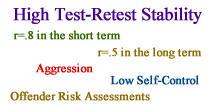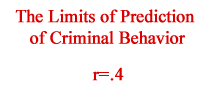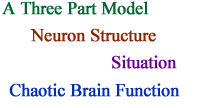Intra-Individual Variability in Criminal Propensity
Intra-Individual Variability in Criminal Propensity
One of the least understood facets of criminal propensity is its intra-individual variability. There is a fair amount of stability in measures of individual criminal propensity. This seen in test-retest reliability studies of measures related to criminal propensity. However, this apparent stability seems to drop off remarkably as one tries to predict future criminal behavior. The prediction of criminal behavior appears to run into the r=.4 limit of prediction found in predictors of other human traits. Some of the problems with the prediction of criminal behavior could be due to the large number of covariates of criminal propensity, but these problems could also be due to large levels of within individual variation in criminal propensity. The “limits of prediction” problem has been explored in studies of other human traits, and especially in the personality literature. In the personality literature, the problem of poor predictability of traits is addressed by conceptualizing traits as collections of states.

High Test-Retest Stability in Criminal Propensity
Measures of characteristics that are related to criminal propensity tend to have a high test-retest stability. The levels of test-retest stability in measures such as aggression, low self control, or offender recidivism risk appear to be as high as those found in other measures of human capacity such as personality or intelligence. There is an r=.8 test-retest stability in these measures in the short term and an r=.5 level of stability out to several years.

The Limits of Prediction of Criminal Behavior
Although there is a high test-retest stability in measures related to criminal propensity, criminal behavior is very hard to predict. The predictive validity of the most accurate measures of criminal behavior rarely exceeds r=.4. The r=.4 prediction limit also is seen in other trait measures such as personality measures. The reason for the limits of prediction are not well understood. How could something with fairly stable covariates be so hard to predict?.

Traits as Collections of States
The limits of prediction have been explored fairly extensively in the personality literature. It is difficult to predict human behavior of any type at better than r=.4 levels. One of the promising approaches to explaining this problem has been to conceptualize traits as collections of states. A multiple state model tends to explain something that has both stable and time varying properties.

A Three Part Model
The reasons that criminal behavior is so hard to predict may ultimately resolve to a three part model. In the first part of the model, it is noted that neuron structure in the brain is fairly stable over time. It can take many months for neuron structures to change. In the second part of the model, the effects of situation are noted. People tend to have consistency in behavior in similar situations and inconsistency of behavior between different types of situations. The brain is essentially a chaotic processor. Various parts of the brain are constantly being primed at random, and the behavioral responses created by the brain vary with changes in brain priming. Although this process is not well understood, it could help explain the problems with prediction of criminal behavior.
